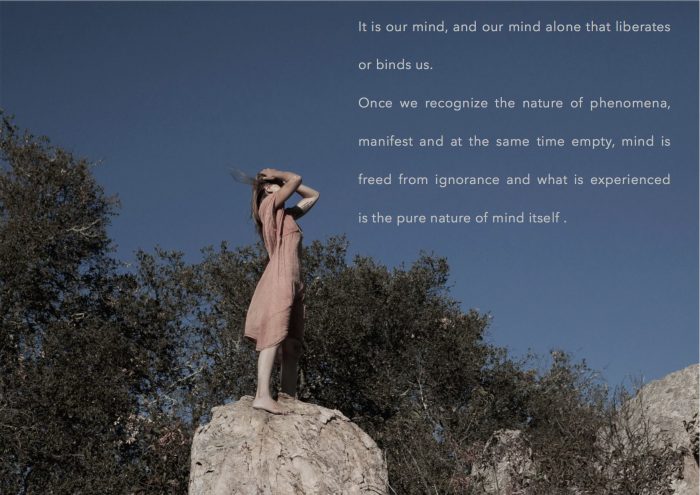Over the last couple of years, I have danced the fine line between maintaining a sense of continuity in existence and dissolving my clinging to a sense of a solid self.
I have seen that people on a similar path often experience this phase as challenging. Often resulting in confusion and suffering, and such as emotions of loneliness, disconnection, and/or separation.
As we embark on the spiritual path we begin to learn and essentially remember a deeper sense of a profound, and even more so fundamental, reality/existence within and without us.
On the journey of looking beyond dualistic self-centeredness, we gradually see through appearances, misconceptions of authenticity, and ultimately our conditioning of ego-identity—as we try to fulfill the expectations of society, family members, and friends, being a good husband or wife, mother or father, lover or employee. While there is a gradual learning curve of deepening one’s perception beyond our five-sensory cognition, we notice the tendency to engage in survival-oriented egoic behavior and protect our role-playing to fulfill social standards and expectations.
Over time, we are fooled less and less by our conceptual thinking patterns and step out of habitual thought loops. This process of realization does not necessarily feel liberating at the beginning; instead, it feels like we are lying on an open table and the ripple effects of self-realization are cutting through us.
Chögyam Trungpa, a Tibetan Buddhist meditation master, highlights the common pitfalls to which some individuals on spiritual paths fall prey:
“The spiritual path is not fun—better not to begin. If you must begin, then go all the way, because if you begin and quit, the unfinished business you have left behind begins to haunt you all the time. (…) Stepping on the path means your experiences become penetrating, naked, and obvious. Then you might try to escape, but your avoidance creates pain, which in turn inspires you to continue on the path. So your setbacks and suffering are part of the creative process of the path.”
Almost everyone I have encountered who is seriously engaged in their spiritual practice can confirm Trungpa’s observation. It is a process of allowing the old “self” to die, while bringing a new understanding of existence to the surface. This transition normally does not happen overnight; it is certainly a process and not often a sprint. Although this time is often characterized by confusion and fear (of essentially letting go of the persona we thought we were), we can clearly see the opportunity that this fresh perspective of existence offers. It invites us to self-inquiry and can support us in our individual human development, as well as providing a chance for growth.
Throughout this phase it is common for questions to arise that penetrate one’s previous understanding of life and self:
>> How can I navigate through the complexity of my existence?
>> How can I find a seat on both planes of existence without neglecting one for the other?
>> How can I fully embody the human experience while seeing through the illusion of an independent manifestation?
In my own life, I have danced this fine line in various ways. While experiencing a new dimension of existence I have often found myself using spiritual philosophy/understanding to reinforce the denial of the human experience, leaned into spiritual bypassing, and bought into spiritual materialism.
Spiritual bypassing, a term coined by psychologist John Welwood, refers to the use of spiritual practices to avoid dealing with human emotions. “All is One,” “the Law of Attraction,” and “this is all your story” become common phrases in daily life circumstances.
In situations of personal conflict, I have experienced my partner throwing comments back at me like, ‘This is all your perception and has nothing to do with me,” “that is all your karma,” and “that all comes from your own confusion,” which didn’t allow a mature dialogue between two people.
Sooner or later, cutting through spiritual materialism (a term that Chögyam Trungpa originated), is the necessary action one needs to undertake in order to pull oneself out self-deception in spiritual seeking.
At times along the way I have also consciously kept myself trapped in human conditioning to avoid “spiritual” experiences. Such experiences might require a stripping away of old concepts about who I thought I was and stories I told myself. I avoided doing any shadow work and going deep down the rabbit hole.
Over the past years, as I worked through (still working through it at times!) my own confusion, and I came to realize that a holistic understanding of existence seems to be the ground of all meaningful conversations and connections. There is an urge to enter into a dialogue within which one can hold both views of existence. It all comes down to the question:
Where am I as a link that connects the underlying unity of these two planes of existence?
We must understand that the spiritual path is not separate from human existence.
It is essential that we stop distinguishing between the earthly/human and spiritual experience of being-ness. Seeing them as separate only reinforces the mind’s confusion.
Instead, the key seems to be accepting that both experiences of existence have their place in our lives. One can function on both planes simultaneously. That is essentially what the spiritual path requires and generously offers.
~












Read 0 comments and reply